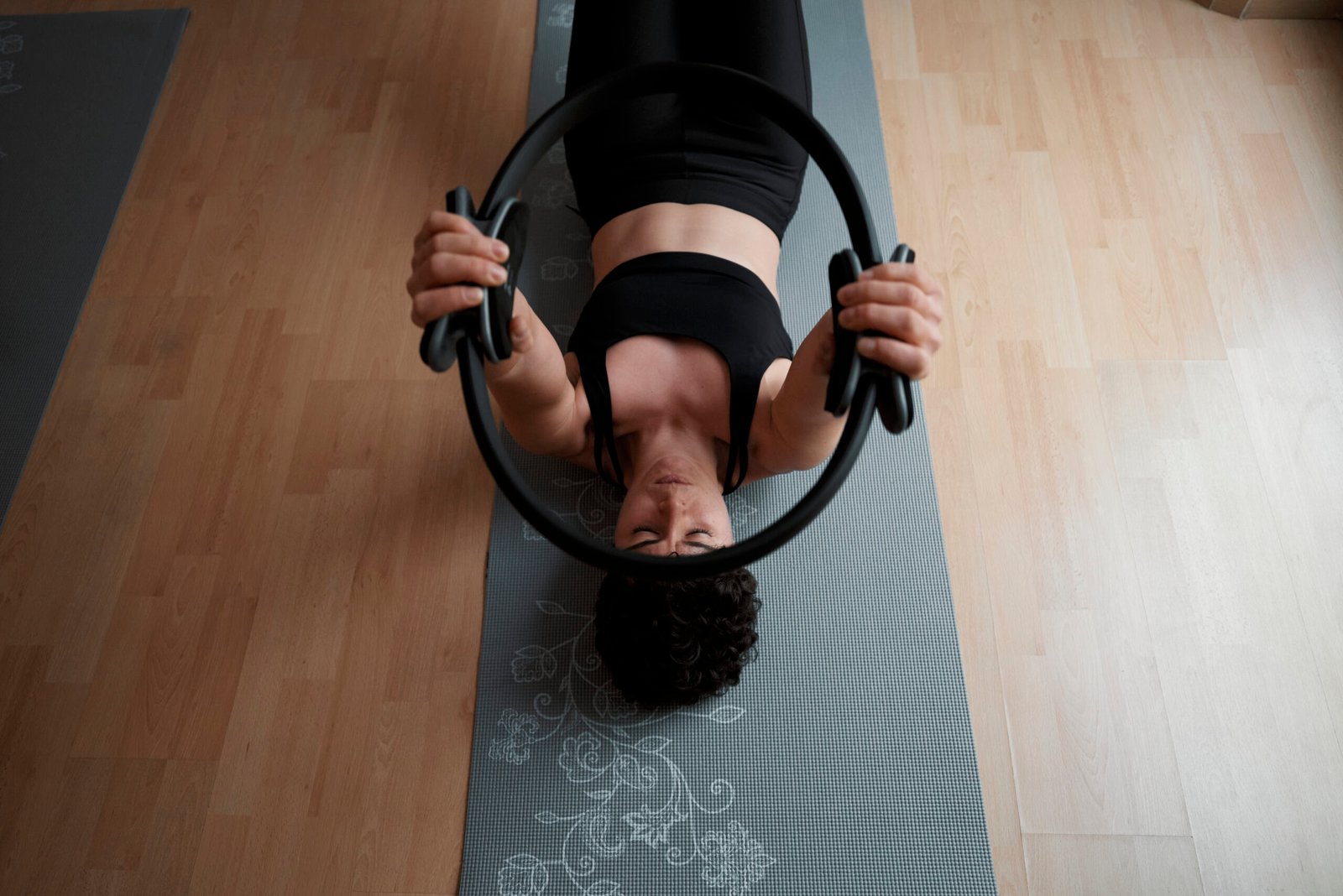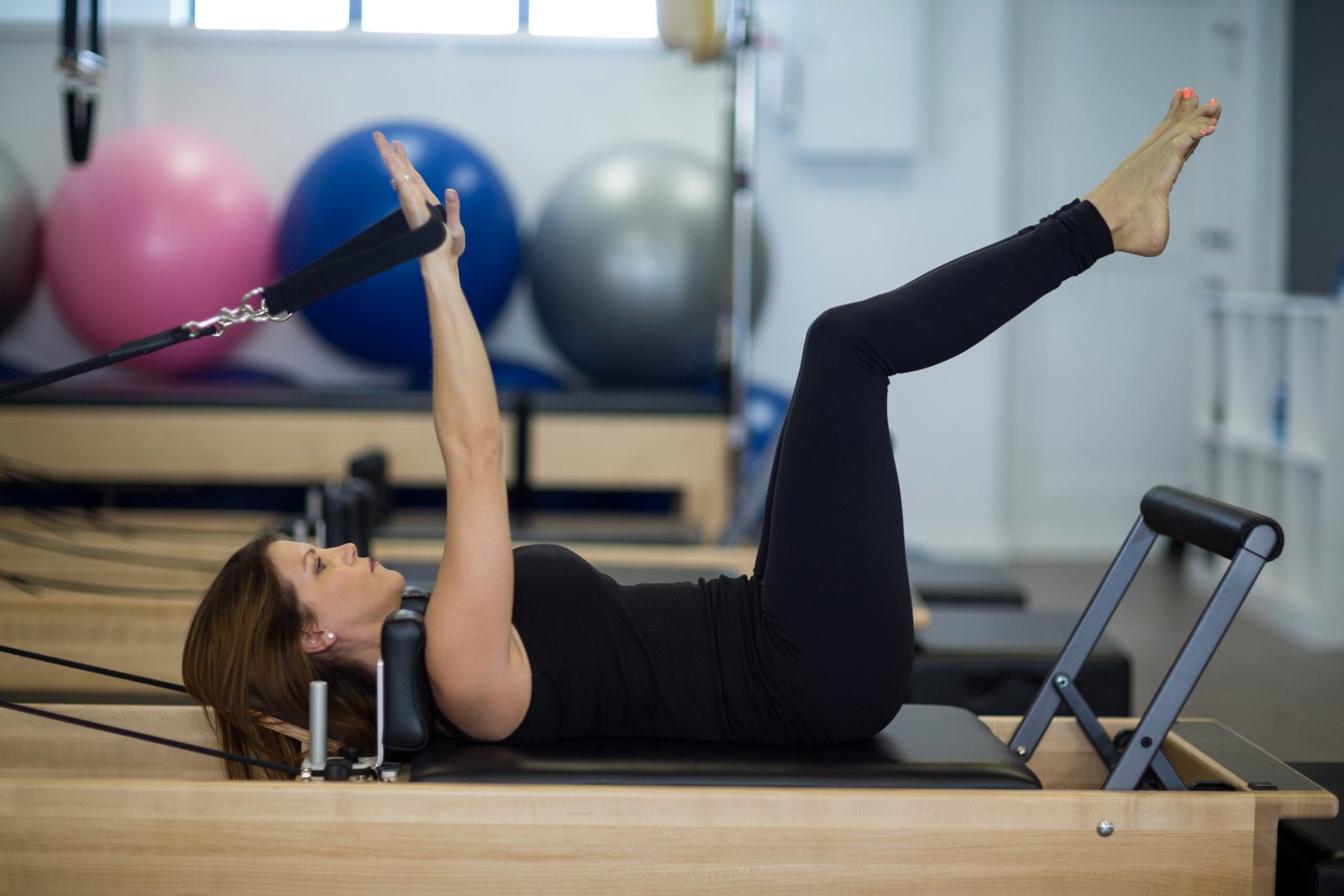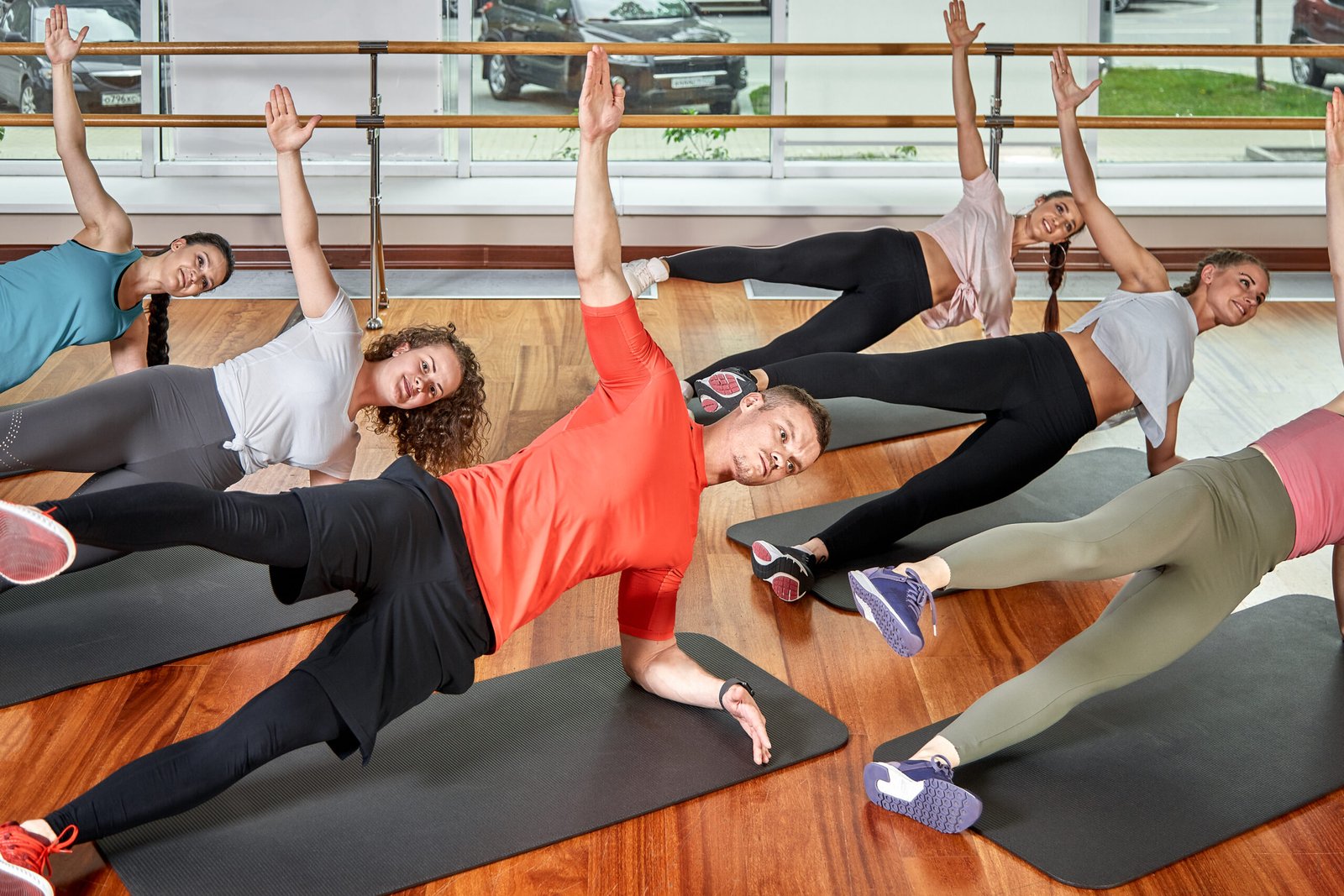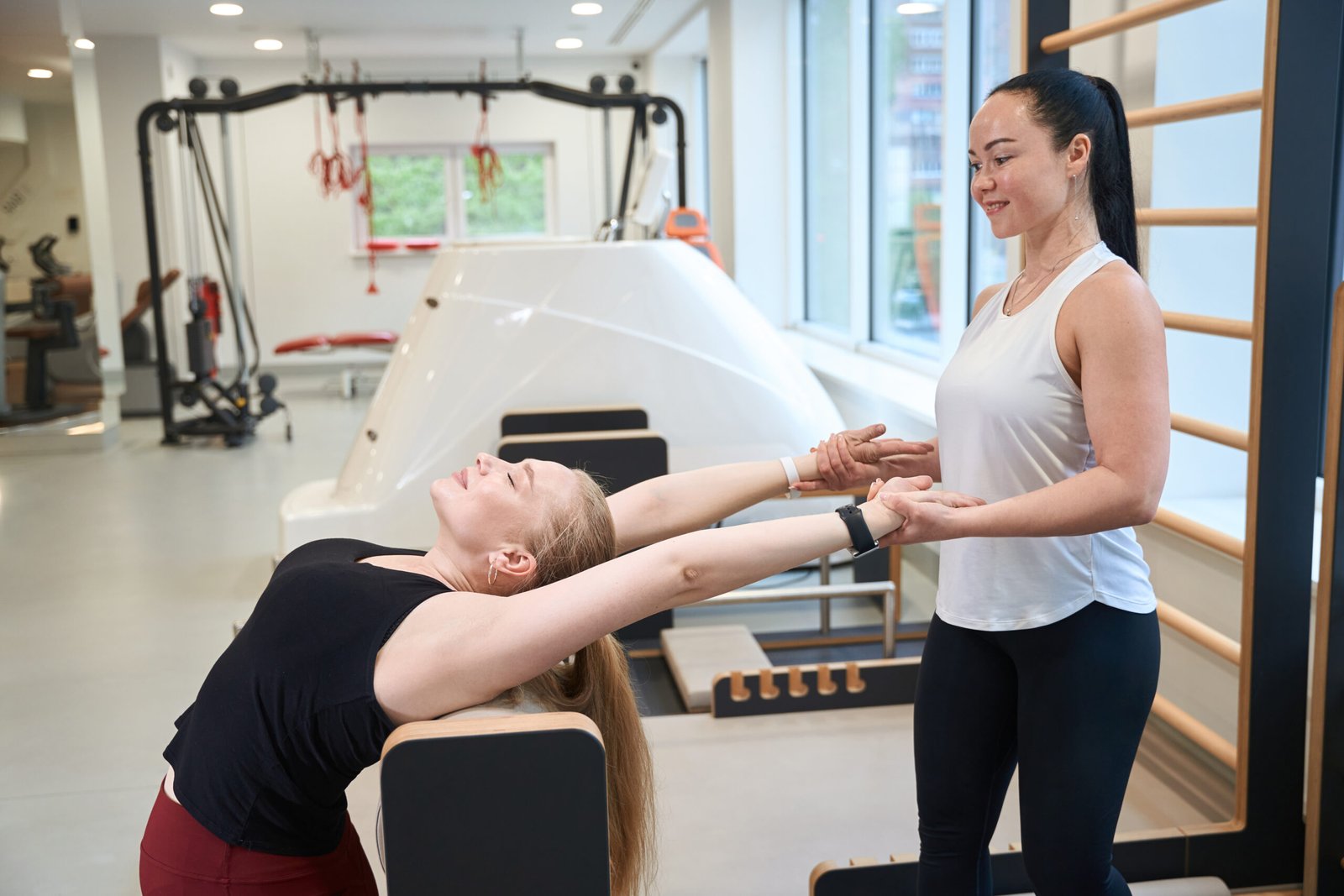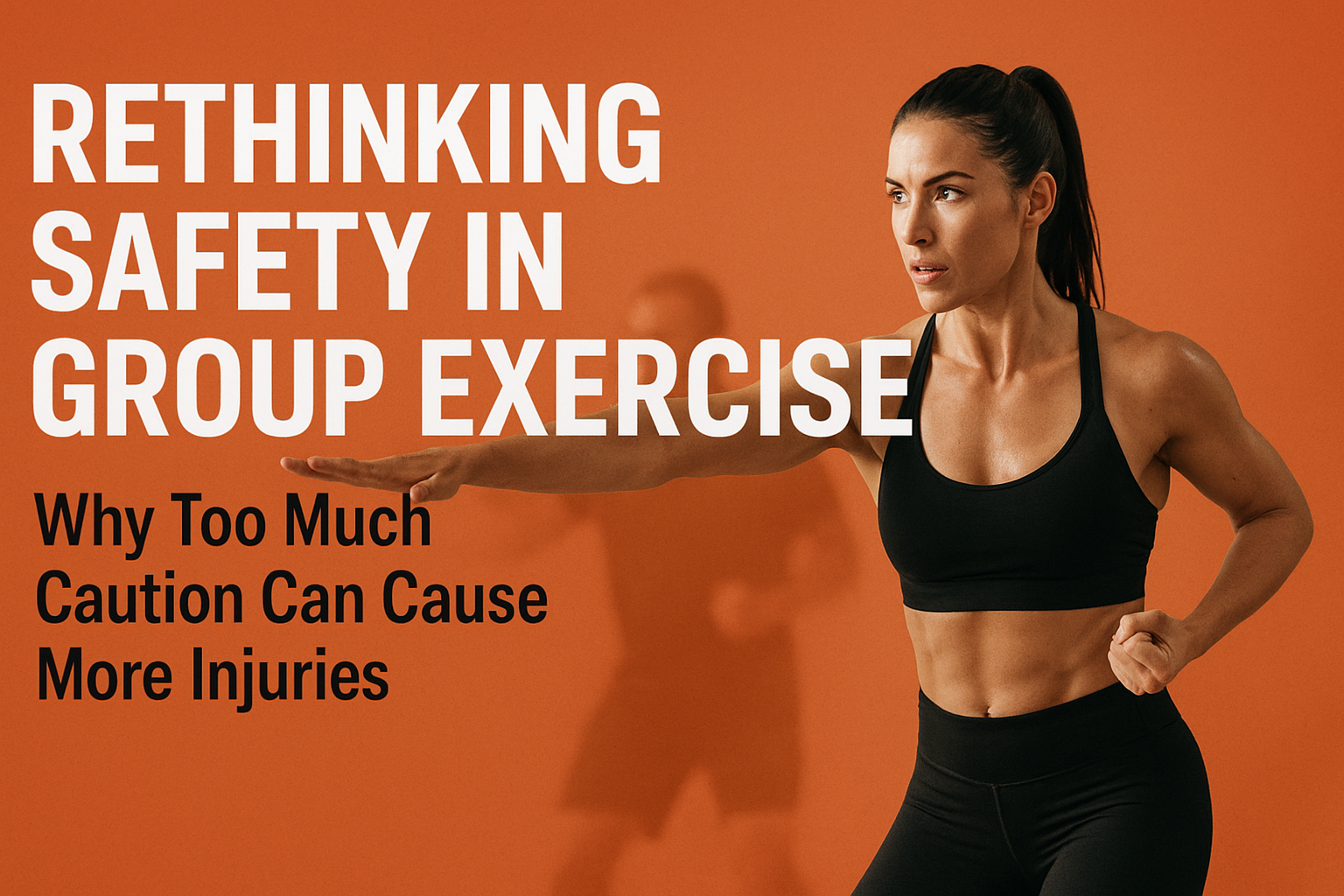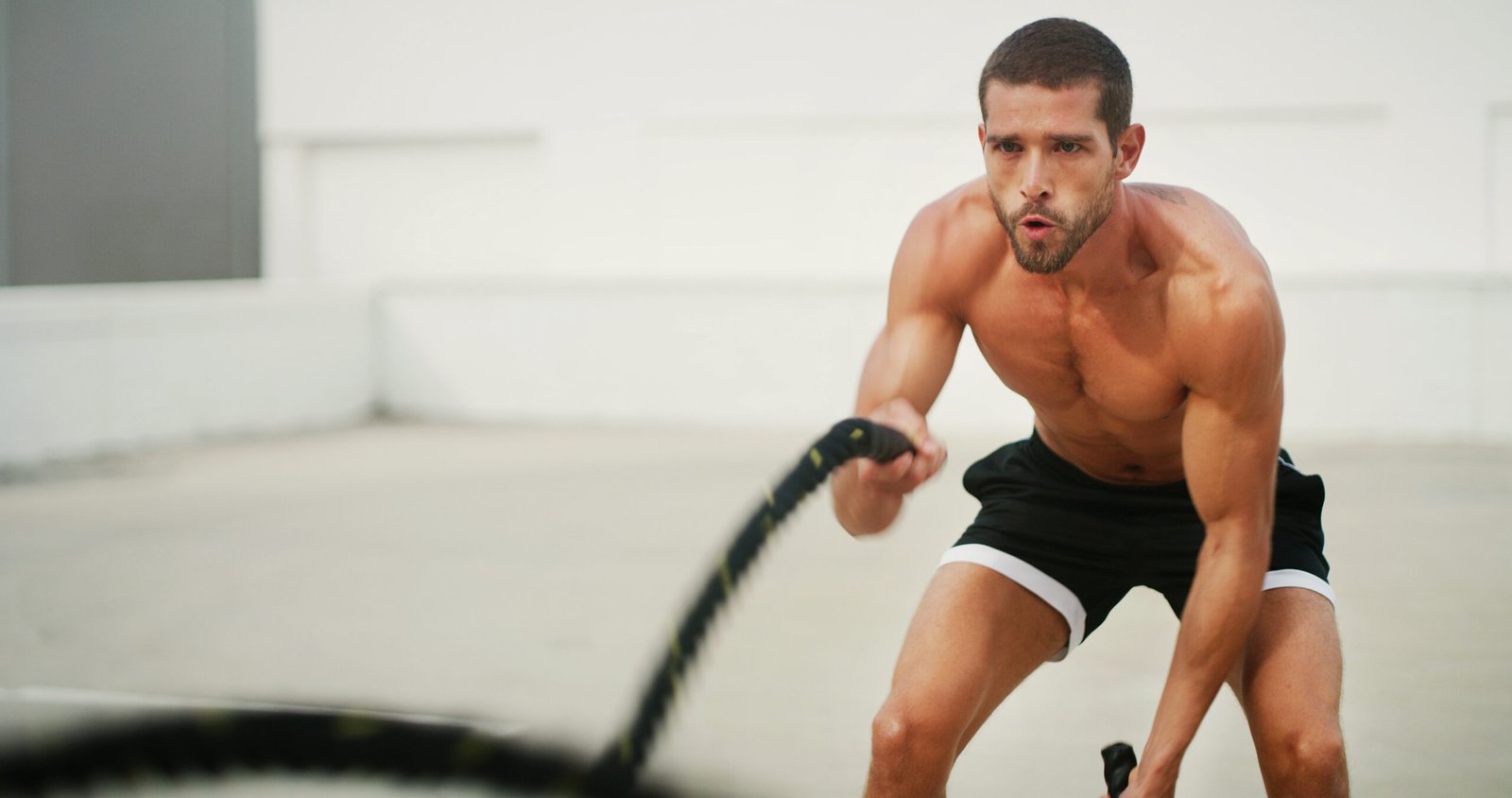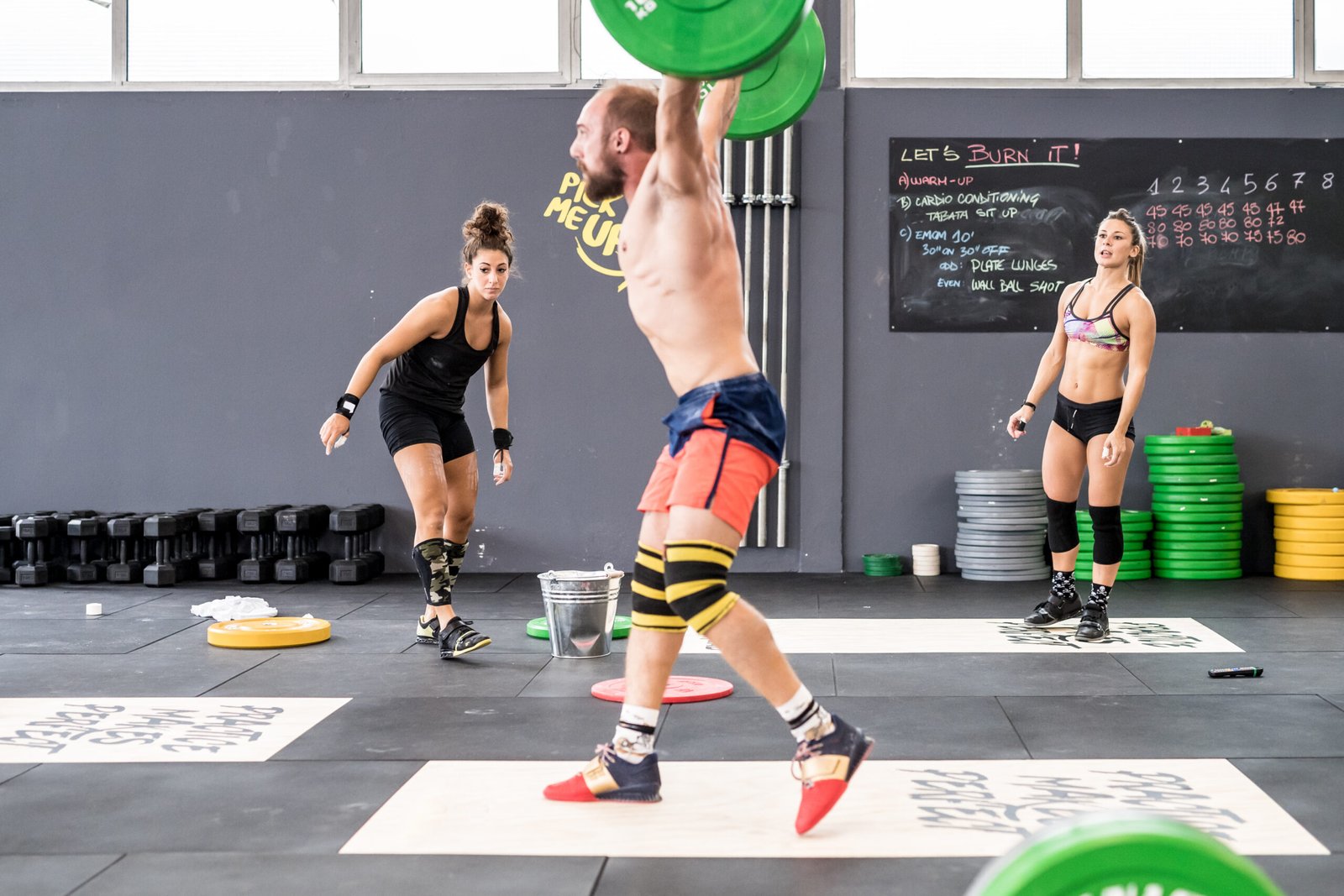Maintaining good posture is crucial not only for physical health but also for mental well-being. It affects how we perceive ourselves and how others perceive us. While modern life often leads to poor posture due to prolonged sitting and the use of technology, Pilates can offer a remedy. Pilates for posture improvement involves specific exercises that target core strength, flexibility, and alignment to address common posture problems. With the right techniques and dedication, Pilates can transform your stance, enhance your confidence, and contribute to overall well-being. Let’s explore how to harness the power of Pilates to achieve a posture that reflects poise and vitality.
How to Do These Pilates Posture Correction Exercises:
| Posture Principle | Description | Benefits |
|---|---|---|
| Engaging Your Core | Pulling your belly button towards your spine activates core muscles, building a strong foundation. | Protects the back, stabilizes the spine, and enhances overall stability. |
| Spine Alignment | Ensuring your head, shoulders, and pelvis are in line to prevent strain and maximize exercise effect. | Distributes forces evenly and supports long-term posture improvement. |
| Controlled Breathing | Inhaling deeply through your nose and exhaling fully through your mouth during exercises. | Increases muscle engagement, promotes relaxation, and improves posture. |
| Attention to Form | Performing slow, precise movements with a focus on form. | Prevents injury, targets muscle groups effectively, and reinforces good posture habits. |
| Stretching & Strengthening Integration | Combining stretching and strengthening exercises to balance flexibility and muscle strength. | Promotes muscle balance, flexibility, and proper spine support. |
Engaging Your Core: When starting Pilates exercises for posture correction, the first and foremost step is to engage your core muscles. Pulling your navel towards your spine not only builds a strong foundation but also protects your back and enhances your overall stability. A well-engaged core supports your spine, preventing the collapse or exaggerated arching often seen with poor posture. During Pilates, maintaining this core engagement throughout each movement ensures that you’re not just going through the motions, but actively working towards posture correction.
– Navel to spine: Pull your belly button towards your spine to activate core muscles.
– Back support: Engaged core muscles protect the lower back during exercises.
– Stability foundation: A strong core provides the foundation for all Pilates movements.
– Posture enhancement: Core strength promotes a stable and upright posture.
Spine Alignment: Correct spine alignment is critical in Pilates exercises to tackle posture problems. Ensuring that your head, shoulders, and pelvis are in line throughout each exercise can prevent unnecessary strain and maximize the effectiveness of your workout. Proper alignment helps distribute your body’s forces evenly, leading to a more balanced and coordinated stance. Focusing on this alignment in Pilates reinforces muscles that naturally support the spine, aiding in the long-term improvement of posture.
– Head position: Keep your head aligned with your spine for optimal alignment.
– Shoulder square: Ensure shoulders are not hunched or elevated unnaturally.
– Pelvic placement: Align your pelvis neutrally to support natural spine curvature.
– Balance distribution: Appropriate alignment aids in equal force distribution.
Controlled Breathing Techniques: Breathing is more than just a necessity; in Pilates, it’s a tool for enhancing exercise efficacy. Controlled breathing—specifically inhaling deeply through your nose and exhaling fully through your mouth—improves concentration and stability during exercises. It can help you maintain rhythm and posture, as well as engage your muscles more effectively. Deep breathing also helps in relaxing muscles that are unnecessarily tensed, thus aiding in proper posture alignment.

– Breath rhythm: Use breathing to maintain exercise rhythm and stability.
– Enhance focus: Deep breathing improves concentration on posture.
– Relaxation aid: Helps release unnecessary muscle tension affecting posture.
– Efficiency boost: Proper breathing increases muscle engagement efficacy.
Attention to Form: Precision is key in performing Pilates exercises. Carrying out each movement slowly and precisely maximizes their effectiveness while minimizing the risk of injury. By focusing on form, you ensure that each movement targets the intended muscle group, aiding in posture correction and muscle strengthening. Attention to form doesn’t just prevent injury; it reinforces good posture habits by training your body to move correctly even outside of exercises.
– Movement precision: Slow, controlled movements ensure form correctness.
– Targeted engagement: Ensures exercises target muscles effectively.
– Injury prevention: Proper form reduces the risk of exercise-related injuries.
– Habit reinforcement: Trains the body for correct posture naturally.
Stretching and Strengthening Integration: To effectively improve posture, it’s essential to blend stretching and strengthening exercises in your Pilates routine. Stretching aids in flexibility and alleviates tension in shortened muscles, while strengthening helps in building the muscles that support the spine. This combination promotes muscle balance—essential for a well-aligned posture. A regular practice blending both elements not only supports better posture but also enhances muscle coordination and overall body movement.
– Flexibility boosts: Stretching increases muscle flexibility.
– Tension relief: Reduces tightness in shortened muscles.
– Supportive strength: Builds muscles crucial for spine support.
– Muscle balance: Promotes balanced engagement across the body.
7 Best Pilates Posture Correction Exercises
If you’re aiming to address and improve common posture issues, these seven Pilates exercises can be transformative. They are designed to enhance alignment, increase strength, and boost flexibility, paving the way for better posture. This selection not only supports physical adjustments but also fosters a sense of confidence and well-being that extends beyond the mat.
| Exercise | Target Area | Key Benefits | Tips for Effectiveness |
|---|---|---|---|
| Seated Side Stretch | Obliques, Shoulders, Back | Enhances spinal alignment, increases flexibility, and relieves shoulder stiffness. | Maintain a straight back and stretch gently to avoid overstraining. |
| Saw | Spine, Obliques, Core | Promotes spinal relief, stabilizes the core, and improves breathing coordination. | Move slowly and coordinate with deep breaths for optimal results. |
| Upper Back Extension | Thoracic Spine, Shoulders | Strengthens the upper back, reduces neck tension, and improves posture. | Focus on maintaining a neutral pelvis during the exercise. |
| Swimming | Back, Shoulders, Core | Enhances core stability, improves shoulder mobility, and balances body posture. | Perform with controlled movements to maximize core engagement. |
| Thread the Needle | Shoulders, Spine | Improves shoulder mobility and spinal rotation, leading to better posture. | Engage your core while rotating to deepen the stretch. |
| 2-Point Kneeling | Core, Spine, Shoulders | Boosts core stability, improves spinal alignment, and builds muscle strength. | Keep your movements controlled and focus on balance. |
| Leg Pull Front | Core, Back, Shoulders | Strengthens the core and back muscles, enhancing posture and stability. | Keep your torso in a straight line while lifting your leg and arm. |
Seated Side Stretch: The seated side stretch is an effective Pilates exercise focusing on lengthening the sides of your body. This movement primarily targets the oblique muscles, contributing significantly to spinal alignment and flexibility. By practicing this stretch, not only do you relieve stiffness in the shoulders and back—which is vital for correcting posture—but you also promote a balanced posture. The adaptability of this exercise makes it suitable for various fitness levels, ensuring anyone can access the benefits of improved body awareness and alignment.
– Oblique target: Engages the oblique muscles gently to enhance flexibility.
– Shoulder relief: Alleviates tightness in the shoulder area.
– Versatile option: Can be modified for any fitness level.
– Daily activity boost: Promotes confident alignment awareness.
Saw: A classic move in Pilates, the “Saw” exercise promotes flexibility and tension relief along the spine, targeting the obliques in particular. What makes the “Saw” beneficial is its focus on even alignment and core stabilization, which are key components of maintaining good posture. This exercise also encourages coordinated breathing, enhancing overall body awareness and leading to improved postural habits over time. Incorporating the “Saw” into your Pilates practice regularly can reduce back discomfort and enhance your stance and movement confidence.
– Spinal relief: Stretches and reduces spine tension.
– Core stabilization: Encourages even core alignment and stability.
– Breathing coordination: Promotes mindful breathing for posture.
– Confidence enhancement: Motivates a better stance and movement practice.

Upper Back Extension: Strengthening and opening up the thoracic spine is crucial for overcoming a slumped posture, and the upper back extension exercise does just that. This movement realigns the spine and counteracts the negative effects of prolonged sitting by engaging the back muscles and enhancing flexibility. Regularly incorporating the upper back extension into your routine can lead to reduced neck and shoulder tension and a perceivable improvement in your posture. It’s an ideal choice for individuals striving for more height perception through upright posture and confidence.
– Thoracic focus: Targets the upper back and thoracic spine.
– Corrects slump: Counters prolonged sitting effects.
– Neck relief: Reduces neck and shoulder tension.
– Height perception: Encourages a more upright stance.
Swimming: In the realm of Pilates, swimming is more than a water activity—it deeply enhances core stability and promotes good posture by strengthening back muscles. This exercise helps improve shoulder mobility, which is often compromised by slouching. Engaging in the swimming exercise regularly not only improves body coordination but also teaches better body alignment, contributing to increased lung capacity and overall body balance.
– Core strengthening: Focuses on building core stability.
– Shoulder mobility: Improves shoulder movement range.
– Coordination enhancement: Promotes better body alignment and balance.
– Lung capacity: Increases breathing efficiency and lung health.
Thread the Needle: “Thread the Needle” is a Pilates exercise that focuses on improving shoulder mobility and spinal rotation, both critical for better posture. By targeting the chest and shoulders’ release, it helps to balance muscle engagement, which is essential for proper alignment. Regular practice leads to a more open and upright posture while boosting confidence through enhanced body awareness and flexibility.
– Shoulder mobility: Eases shoulder movement and flexibility.
– Spinal rotation: Aids in correcting spinal misalignment.
– Muscle balance: Ensures even muscle engagement.
– Confidence boost: Promotes an open, upright stance.
2-Point Kneeling (Quadruped): The 2-point kneeling exercise is fundamental in Pilates for improving core stability and addressing posture. By lifting one arm and the opposite leg while on all fours, this movement challenges balance and encourages a strong core. Practicing this exercise can improve spinal alignment and muscle coordination, tackling common posture-related problems and building the strength necessary for maintaining an upright posture.
– Core challenge: Enhances core balance and stability.
– Spinal coordination: Promotes better spinal alignment.
– Muscle strength: Builds overall upper and lower body strength.
– Posture confidence: Encourages maintaining an upright posture.
Leg Pull Front: The Leg Pull Front exercise targets the core, shoulders, and back muscles, aiming to improve alignment and stability, crucial for good posture. Engaging the abdominal muscles during this exercise helps in developing a robust foundation, vital for good posture. Ensuring proper form and using controlled movements maximize the exercise’s benefits while preventing strain. Regular practice not only influences posture improvement but also boosts overall body confidence.
– Core engagement: Strengthens core essential for stability.
– Alignment improvement: Enhances overall body alignment.
– Muscle activation: Activates muscle groups critical for posture.
– Confidence uplift: Increases body confidence through improved posture.
Exercises to Improve Posture at Home
| Exercise | Target Area | Key Benefits | Instructions |
|---|---|---|---|
| Breaststroke Prep | Spine, Shoulders, Chest | Elongates the spine and improves alignment. | Lie on your stomach, focus on lengthening the spine during each movement. |
| Spine Stretch Forward | Spine, Hamstrings, Back | Improves flexibility and encourages natural spine movement. | Ensure that your feet remain flexed and your spine stays aligned throughout. |
| Bridge | Core, Glutes, Lower Back | Strengthens the core and glutes while aligning the spine. | Focus on pelvis position, lifting slowly and with control. |
| Plank | Core, Shoulders, Back | Strengthens the core and enhances spinal integrity. | Maintain a straight line from head to heels, avoiding sagging hips. |
| Chest Opener | Chest, Shoulders, Upper Back | Relieves tension in the chest and shoulders, enhancing thoracic mobility. | Keep the chest open and stretch slowly to avoid overstretching. |
| Back Extension | Spine, Glutes, Hamstrings | Strengthens the back muscles and reduces tension from slouching. | Perform with slow movements, focusing on the upper back engagement. |
Pilates holds incredible power to enhance your posture right from the comfort of your home. Incorporating specific Pilates techniques into your daily routine can effectively target and resolve common posture problems. By focusing on strengthening core muscles and increasing flexibility, at-home Pilates exercises can lead to improved balance, coordination, and an aligned posture—allowing you to feel more confident in your regular activities. These exercises, such as Breaststroke Prep and Spine Stretch Forward, are excellent for aligning and elongating your spine, adapting to fit individual needs, and gently progressing towards optimal posture over time.
– Breaststroke Prep: Focuses on spine elongation and alignment.
– Spine Stretch Forward: Encourages natural spine movement and flexibility.
– Balance improvement: Enhances overall body balance and coordination.
– Customizable exercises: Adjusts to suit personal needs and posture goals.
Bridge
The Bridge exercise forms a vital component of Pilates routines focused on postural correction by strengthening core, glute, and lower back muscles. This exercise is particularly effective in aligning the spine through targeted engagement of the muscles supporting the vertebral column. Practicing the Bridge can alleviate lower back pain, a common consequence of poor posture. Emphasizing correct pelvic positioning and body awareness, the Bridge is an accessible exercise that can be adjusted for various fitness levels, making it suitable for anyone committed to improving their posture.
– Core and glute strength: Stabilizes and supports the lower back.
– Spinal alignment: Targets engagement of vertebral support muscles.
– Pain alleviation: Reduces lower back discomfort.
– Accessible practice: Adapts to different fitness levels and postural needs.
Plank
A quintessential exercise in Pilates, the plank strengthens core muscles, crucial for maintaining an optimal posture. By stabilizing the spine and supporting better alignment, planks diminish risks associated with common posture issues. Incorporating planks regularly into your Pilates routine sharpens overall body awareness and balance, resulting in noticeable improvements in your stance and back health. The plank’s versatility allows it to be modified for varying fitness levels, ensuring it remains an integral part of anyone’s journey to better posture.
– Core stability: Strengthens essential muscles for spine support.
– Spinal integrity: Enhances alignment reducing posture-related risks.
– Body awareness: Improves overall balance and awareness.
– Versatile exercise: Adaptable for different fitness levels.

Chest Opener
Countering the effects of slouching, the Chest Opener exercise improves posture by opening up the chest and shoulders. It strengthens the upper back muscles and promotes better spinal alignment. This exercise is particularly advantageous for individuals spending long hours sitting, as it relieves tension and improves mobility in the thoracic region. Regular practice of the Chest Opener enhances breathing capacity by allowing fuller ribcage expansion, leading to a more upright posture and increased confidence.
– Upper back strength: Builds muscles for better spinal support.
– Tension release: Alleviates stress in shoulder and chest muscles.
– Thoracic mobility: Enhances upper back movement and flexibility.
– Breathing capacity: Promotes deeper and fuller breaths.
Back Extension
Practicing back extensions can significantly contribute to improved posture and spinal alignment. This Pilates exercise targets the muscles along your spine, namely the erector spinae, glutes, and hamstrings, effectively counteracting prolonged sitting and forward slouching. By alleviating tension in the upper back and neck, back extensions reduce discomfort and stiffness often linked to poor posture. The emphasis on controlled movement and breath work enhances core stability, making back extensions a valuable addition to any posture-focused routine—suitable for all fitness levels.
– Spinal focus: Strengthens muscles supporting spinal alignment.
– Tension alleviation: Reduces upper back and neck discomfort.
– Controlled exercise: Emphasizes movement precision and breath work.
– Core stability: Strengthens core for a balanced posture.
Visualization
Visualization techniques can transform your Pilates workout into a more effective posture correction session by focusing on alignment and technique. By imagining yourself being pulled upward by a string, for instance, you can correct issues like rounded shoulders or forward head posture. This mental approach, when combined with Pilates movements, enhances muscle engagement and promotes better form, leading to long-term posture improvements and increased confidence.
– Alignment focus: Improves visualization-based correctness.
– Posture correction: Aids in resolving common posture issues.
– Muscle engagement: Boosts engagement through mental imagery.
– Form enhancement: Improves movement form and precision.
Elevate Your Confidence with Pilates
Investing time in Pilates exercises tailored for posture improvement not only rectifies physical imbalances but also enhances confidence and overall well-being. Whether you’re incorporating exercises like the seated side stretch, the plank, or visualization techniques, each movement provides tangible benefits towards aligning your spine and strengthening supportive muscles. As you continue on this posture-improving journey with Pilate’s exercises, you’ll likely notice significant physical and mental transformations that inspire a more poised and self-assured reflection in everyday life. Your commitment to prioritizing your posture through Pilates not only fosters a healthier body but also cultivates a resilient mindset. Consistency is key—regular practice of Pilates exercises ensures progressive alignment and fortified back, core, and shoulder muscles, essential for combating common posture issues like rounded shoulders and slouched stance. Moreover, by engaging deeply with each session, you’re not just building physical strength but also increasing body awareness, which translates into better postural habits outside the studio. Discover the confidence that comes with standing tall and reclaiming your physical presence. Whether you’re new to Pilates or seeking to enhance your routine, incorporating these exercises is a step towards achieving impeccable posture and, consequently, a more empowered version of yourself.

